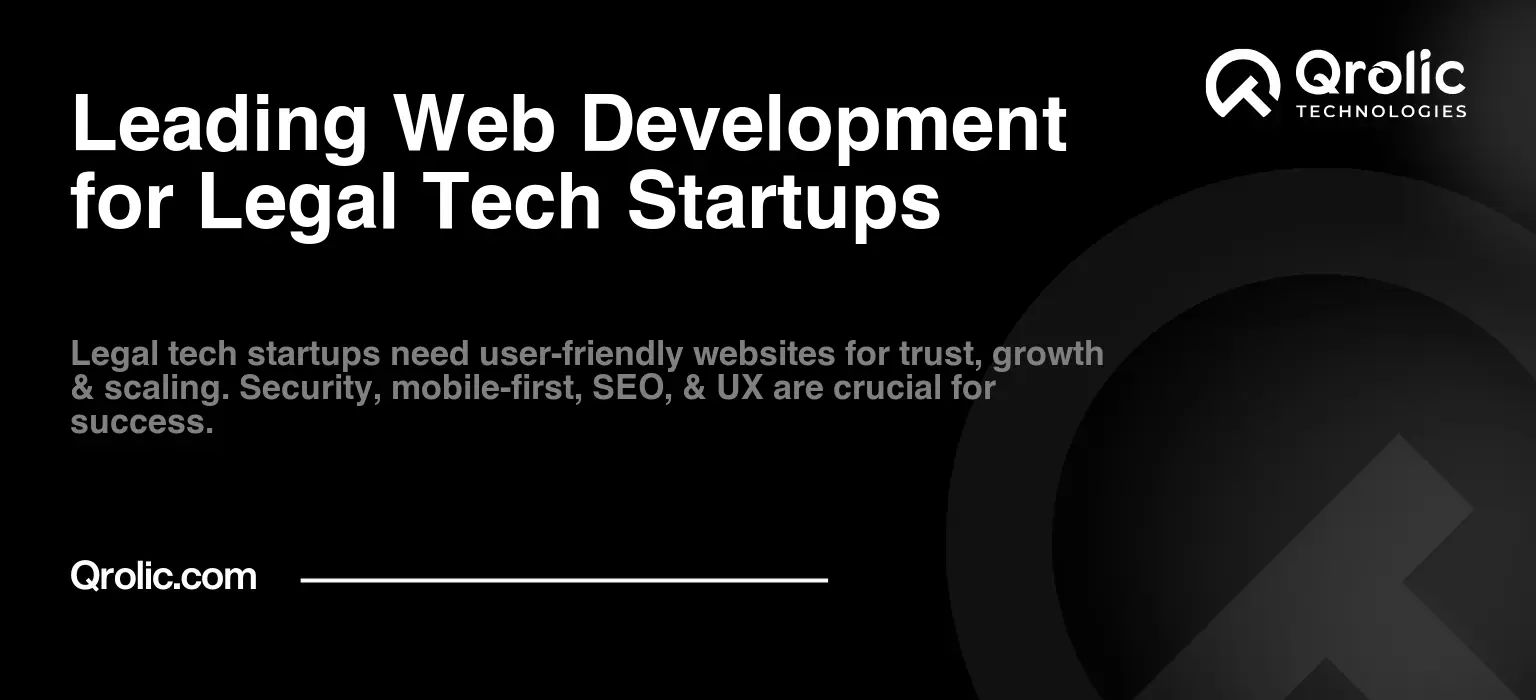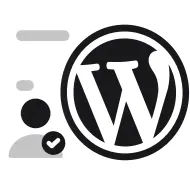The legal industry, traditionally perceived as slow-moving and resistant to change, is experiencing a technological renaissance. Legal tech startups are emerging rapidly, poised to disrupt established practices and streamline access to justice. However, a brilliant idea and innovative technology aren’t enough. A robust, user-friendly website is crucial for these startups to establish credibility, attract clients, and scale their operations. This article delves into the intricacies of leading web development for legal tech startups, providing insights, strategies, and best practices to ensure success in this competitive landscape.
Quick Summary:
- A strong website builds trust and attracts legal tech clients.
- Prioritize security, mobile-first design, and user experience.
- Plan, develop, test, and maintain your legal tech site.
Table of Contents
- The Crucial Role of Web Development for Legal Tech Startups
- Building Trust and Credibility
- Showcasing Expertise
- Attracting and Retaining Clients
- User-Centric Design
- Streamlining Operations and Client Interactions
- Automating Processes
- Key Considerations for Legal Tech Web Development
- Security and Compliance
- Data Protection
- Mobile-First Design
- Optimized Performance
- User Experience (UX) and Accessibility
- WCAG Compliance
- Integration with Legal Tools and Platforms
- APIs and Webhooks
- Scalability and Future Growth
- Cloud Infrastructure
- Search Engine Optimization (SEO)
- Keyword Research
- Content Marketing
- Practical Steps to Lead Web Development for Legal Tech Startups
- Step 1: Defining Goals and Objectives
- SMART Goals
- Step 2: User Research and Persona Development
- Empathy Mapping
- Step 3: Information Architecture and Wireframing
- Sitemap Planning
- Low-Fidelity Prototypes
- Step 4: Visual Design and Branding
- Brand Consistency
- User Interface (UI) Design
- Step 5: Web Development and Technology Stack
- Content Management System (CMS)
- Technology Selection
- Step 6: Content Creation and Implementation
- Keyword Integration
- Compelling Content
- Step 7: Testing and Quality Assurance (QA)
- Browser and Device Testing
- User Acceptance Testing (UAT)
- Step 8: Deployment and Launch
- Backup and Disaster Recovery
- Launch Day Checklist
- Step 9: Maintenance and Ongoing Optimization
- Performance Monitoring
- SEO Updates
- The Benefits of Partnering with Qrolic Technologies
- Why Choose Qrolic Technologies?
- Conclusion
The Crucial Role of Web Development for Legal Tech Startups
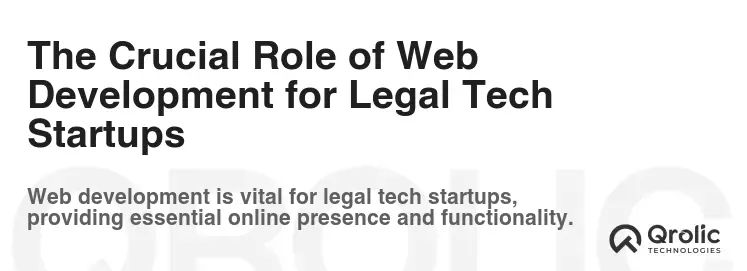
Web development isn’t just about creating a pretty interface; it’s the foundation upon which a legal tech startup builds its entire presence. For legal tech, the stakes are even higher. A poorly designed or malfunctioning website can severely damage trust, a vital currency in the legal profession. Let’s examine why web development is so critical:
Building Trust and Credibility
In the legal field, reputation is paramount. A professional and secure website signals to potential clients that your startup is legitimate, reliable, and trustworthy. A poorly designed site, on the other hand, can raise immediate red flags and send users scrambling to competitors. The website acts as the first point of contact and needs to create a positive, confident impression.
Showcasing Expertise
Legal tech startups are built on innovation and specific expertise. Your website is the perfect platform to showcase these core competencies through well-structured content, case studies, and clear explanations of your technology. Highlighting successful implementations and demonstrating in-depth knowledge can instantly establish your startup as an authority in its niche.
Attracting and Retaining Clients
A website is a powerful lead generation tool. Through strategic search engine optimization (SEO), you can attract potential clients actively looking for solutions to their legal problems. A well-designed site with clear calls to action can guide these leads through the sales funnel, converting them into paying clients.
User-Centric Design
The legal field can be complex and intimidating. Your website needs to be intuitive and easy to navigate, ensuring users can quickly find the information they need. User experience (UX) should be at the forefront of web development decisions, aiming to provide a seamless and stress-free online journey for all users.
Streamlining Operations and Client Interactions
Beyond marketing, a website can streamline many aspects of your legal tech startup’s operations. This can include client portals for secure document sharing, scheduling tools for appointments, and integrated payment gateways for streamlined transactions. These features save time for both your team and your clients.
Automating Processes
By integrating web applications, you can automate repetitive tasks, such as initial intake forms or preliminary document assessments, freeing up your staff to focus on more complex and valuable tasks.
Key Considerations for Legal Tech Web Development
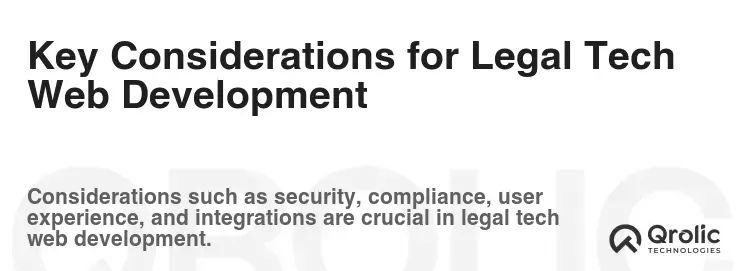
Developing a website for a legal tech startup is vastly different from creating a generic corporate site. Specific challenges and needs must be addressed. Here are essential considerations:
Security and Compliance
Legal tech involves handling highly sensitive and confidential information. Security must be a top priority at every stage of web development. Compliance with regulations like GDPR, CCPA, and HIPAA (where applicable) is crucial. Data encryption, secure servers, and robust user authentication are non-negotiable.
Data Protection
Implement industry-standard security measures such as SSL certificates, regular security audits, and secure database management. Clearly outline your data privacy policies to reassure users about the safety of their information.
Mobile-First Design
A growing number of users access the internet from mobile devices. Your website should be fully responsive, meaning it adapts seamlessly to various screen sizes and resolutions. A mobile-first approach ensures a positive user experience, regardless of the device.
Optimized Performance
Mobile users often have slower internet connections. optimizing your website for speed, including image compression and efficient code, is crucial for ensuring a smooth experience.
User Experience (UX) and Accessibility
Your website should be easy to navigate, visually appealing, and accessible to all users, including those with disabilities. Clear calls to action, intuitive layouts, and readable fonts contribute to a positive user experience.
WCAG Compliance
Web Content Accessibility Guidelines (WCAG) provide a set of standards for creating accessible websites. Adhering to these guidelines will ensure your website is usable by a wider audience.
Integration with Legal Tools and Platforms
Many legal tech startups rely on specific tools and platforms for their core functions, such as case management software, e-discovery platforms, or document automation tools. Seamless integration between your website and these third-party systems is essential.
APIs and Webhooks
Utilizing APIs (Application Programming Interfaces) and webhooks allows for data sharing and real-time communication between your website and other applications, ensuring smooth workflows.
Scalability and Future Growth
Your website should be designed to handle increased traffic and functionality as your startup grows. A scalable infrastructure ensures your website can adapt to the changing needs of your business.
Cloud Infrastructure
Utilizing cloud services can provide the flexibility and scalability needed to manage fluctuating traffic and expanding data needs.
Search Engine Optimization (SEO)
Your website must be discoverable by potential clients searching for legal tech solutions online. SEO strategies are crucial to improve your website’s visibility in search engine results.
Keyword Research
Identify relevant keywords that potential clients are using and incorporate them into your website content, meta descriptions, and alt tags.
Content Marketing
Create valuable, informative, and engaging content related to your expertise in the legal tech field. This will attract organic traffic and establish your startup as a thought leader.
Practical Steps to Lead Web Development for Legal Tech Startups
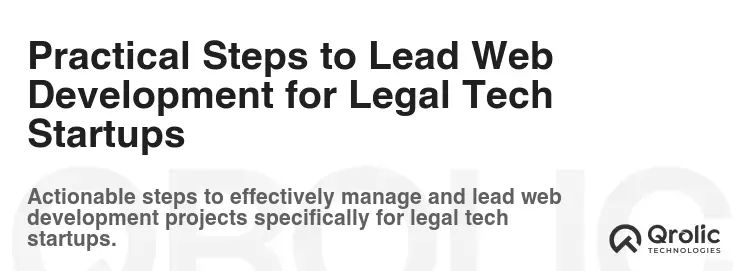
Having established the essential considerations, let’s move on to practical steps in leading web development for legal tech startups:
Step 1: Defining Goals and Objectives
Before coding a single line, clearly define your website’s goals and objectives. What do you want the website to achieve? Generate leads? Build brand awareness? Facilitate client interactions? Clearly defined goals will guide the design and development process.
SMART Goals
Use the SMART (Specific, Measurable, Achievable, Relevant, Time-bound) framework for setting goals. For example, “Increase leads generated through the website by 20% in the next quarter.”
Step 2: User Research and Persona Development
Understanding your target audience is critical. Who are your ideal clients? What are their needs, pain points, and preferences? Conduct user research, such as surveys and interviews, to develop detailed user personas that will inform the design process.
Empathy Mapping
Empathy mapping helps understand users’ feelings, thoughts, and actions, ensuring the website is designed from the user’s perspective.
Step 3: Information Architecture and Wireframing
Plan the structure and navigation of your website. Information architecture (IA) defines how content is organized and labeled. Wireframes are basic visual guides that outline the placement of content and features on each page.
Sitemap Planning
Create a clear sitemap that outlines the relationship between pages, ensuring easy navigation.
Low-Fidelity Prototypes
Start with low-fidelity prototypes to focus on functionality and structure without getting bogged down in visual design.
Step 4: Visual Design and Branding
Create a visually appealing design that aligns with your brand identity. Consider your color palette, typography, and imagery. Your website’s visual design should reinforce your brand message and establish trust.
Brand Consistency
Ensure the website’s design elements align with your company’s overall brand guidelines for consistency across all platforms.
User Interface (UI) Design
Focus on a clean, modern design that is easy on the eyes and provides a seamless user experience.
Step 5: Web Development and Technology Stack
Choose the appropriate technologies for building your website. This includes front-end technologies (HTML, CSS, JavaScript), back-end technologies (server-side languages and databases), and a content management system (CMS).
Content Management System (CMS)
Choose a CMS such as wordpress, Drupal, or Craft CMS that provides ease of use, flexibility, and scalability.
Technology Selection
Select technologies that are compatible with your goals, team expertise, and scalability requirements.
Step 6: Content Creation and Implementation
Develop high-quality, informative content that addresses your target audience’s needs. Implement content strategically throughout your website, focusing on keyword integration and user readability.
Keyword Integration
Strategically integrate your keywords into page titles, headings, and body copy while maintaining a natural tone.
Compelling Content
Create blog posts, articles, case studies, and other resources that demonstrate your expertise and attract potential clients.
Step 7: Testing and Quality Assurance (QA)
Thoroughly test your website on various browsers, devices, and operating systems. Identify and address any bugs or usability issues. QA is crucial for delivering a seamless and reliable user experience.
Browser and Device Testing
Test on major browsers, including Chrome, Firefox, Safari, and Edge, and on various mobile devices and screen sizes.
User Acceptance Testing (UAT)
Involve target users in the testing process to gather feedback and identify usability issues.
Step 8: Deployment and Launch
Once testing is complete, deploy your website to a production environment. Monitor website performance and address any issues that arise post-launch.
Backup and Disaster Recovery
Implement a robust backup strategy and disaster recovery plan to prevent data loss.
Launch Day Checklist
Prepare a comprehensive launch checklist to ensure a smooth deployment process.
Step 9: Maintenance and Ongoing Optimization
Web development is an ongoing process. Regularly monitor your website’s performance, security, and user feedback. Implement updates, security patches, and SEO improvements to keep your site current and effective.
Performance Monitoring
Use website analytics tools to track key performance indicators (KPIs) and identify areas for improvement.
SEO Updates
Continue optimizing your website for search engines to ensure continued visibility and traffic.
The Benefits of Partnering with Qrolic Technologies

Navigating the complexities of web development for a legal tech startup can be challenging. Partnering with an experienced and reliable development firm like Qrolic Technologies (https://qrolic.com/) can significantly increase your chances of success.
Why Choose Qrolic Technologies?
Qrolic Technologies offers a range of services tailored to the needs of legal tech startups, including:
- Custom Web Development: We build bespoke websites that are uniquely tailored to your specific needs and brand identity.
- UI/UX Design: Our focus on user experience ensures your website is not only visually appealing but also easy to use.
- Mobile-First Development: We prioritize mobile responsiveness to ensure a seamless experience across all devices.
- Security and Compliance: We implement robust security measures and ensure compliance with relevant regulations.
- SEO Optimization: We use proven SEO strategies to increase your website’s visibility and attract organic traffic.
- Scalable Solutions: We build websites that can adapt to your growth and evolving needs.
- API Integration: We integrate with third-party tools and platforms, ensuring your website seamlessly works with your existing systems.
- Ongoing Maintenance and Support: We provide continuous support and maintenance to ensure your website is always secure and performs optimally.
Qrolic Technologies’ expertise in legal tech and commitment to innovation makes us the ideal partner for startups seeking to establish a strong online presence.
Conclusion
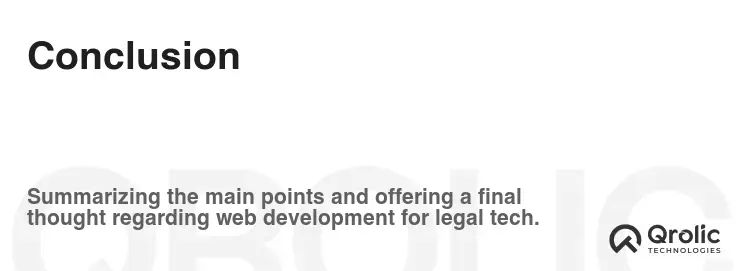
Leading web development for legal tech startups requires a meticulous approach, combining technical expertise with a deep understanding of the unique challenges of the legal industry. By prioritizing security, user experience, mobile responsiveness, and SEO, you can build a website that establishes credibility, attracts clients, and fuels the growth of your legal tech startup. Remember that your website is not a static brochure; it’s an evolving tool that should be continuously optimized to meet the ever-changing needs of your business and the expectations of your target audience. Partnering with an experienced agency, like Qrolic Technologies, can provide the knowledge and resources needed to excel in this competitive landscape. This approach will set your legal tech startup up for long-term success.
